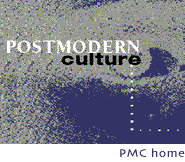
Abstracts
Volume 14, Number 2January, 2004
- Abstract: This essay offers an alternative analysis of the invention of collage, arguing that this technique, most typically viewed as avant-garde and oppositional, is in fact preceded by and rooted in practices pioneered by early mass media advertisers. Beginning with an examination of the orthodox versions of the invention of collage told by art historians, the essay notes how these accounts exclude the role of popular and commercial culture. It then develops a detailed analysis of advertising techniques preceding and informing fine art's invention of collage, suggesting that techniques of critique were first made available through commercial sources. Turning to the work of William S. Burroughs, the essay considers his analysis of mass media as both a source of pernicious social control and a force for critique and social transformation. The essay concludes that the role of collage in both advertising and critical art must be rethought through a dialectic which accounts for collage's origins in the needs of advertising and its promise as a technique for radical critique. --db
- Abstract: In the course of the last 100 years, scholars have repeatedly envisioned a new form of social and cultural critique: one in which the visual would play a much larger role and in which juxtaposition and montage would replace linear and continuous development. We now see Walter Benjamin's Arcades Project as articulating issues that concerned John Berger and Jean Mohr in the 1960s and 1970s and that now take on new urgency in relation to digital imagery and e-text: these increase the possibilities of montage and juxtaposition by hypertext links, as can be seen in the online works of Giles Peaker, Geoff Broadway, Robin Michal, and Russet Lederman. But images and montage do not necessarily produce critique, and Benjamin's "method of juxtaposition" is not quite so portable as Michal suggests. What is lacking with Michal are the multiple perspectives from and on history that we find in works by Broadway and Esther Parada. --gld
- Abstract: The essay begins with a review of a recent court case ruling that video games do not constitute "speech" in order to develop arguments about the relationship between "media" (which communicate) and "activities" (in which, U.S. District Court Judge Stephen Limbaugh argues, any communication is "purely inconsequential"). Focusing on the online role-playing game EverQuest, the essay contends that the combination of game-like structures in EverQuest with certain kinds of expressions (spoken by "virtual" bodies) means that the form cannot be read exclusively either as literature or as a game. Drawing on Benedict Anderson's Imagined Communities, the essay attempts to discern those structural elements in EverQuest that might be understood as shaping or creating large-scale forms of experience (much as the novel, as Anderson argues, gave its readers a new experience of simultaneous time that allowed them to identify in national terms with people they could never hope to know or meet). The essay intends this broadly structural hermeneutic to illustrate the manner in which those things that make EverQuest a game establish the terms by which it participates in culture. Its reading of the game's structure (which is expressed, finally, in the code that makes the software) is designed to map out the expression of that software's intelligence as it interacts with the individual people who play the game (and who do so, almost always, on the game's terms). The essay ultimately argues that EverQuest is an important site for the articulation and experience of cultural and political value, of broader understandings of communities and what they mean, and of the question of "literature" (or, more broadly, "expression") in digital contexts. --eh, ew
- Abstract: Instead of lines or stanzas, contemporary innovative poetry frequently relies on unfamiliar, often highly visual organizing principles. This essay argues that today's "postlinear" poetries represent less a coherent movement or style, though, than a diverse set of inquiries into the interface between visual and verbal means of communication. To demonstrate the difficulties of generalizing about this heterogeneous phenomenon, this essay concentrates on accounting for the origins and function of one device, the word square, in the poetry of Susan Howe. Such a task requires that one examine Howe's early career as an installation artist, her admiration of the painter of Agnes Martin, her apprenticeship to the concrete poet Ian Hamilton Finlay, and the abiding thematic role of the open ocean in her writing. The essay concludes with a brief comparison of Howe's word squares to those employed by another writer, Myung Mi Kim, to illustrate the need for further, case-by-case analysis before critics can claim any reliable mapping of this new phase in the history of English-language verse. --br
David Banash, From Advertising to the Avant-Garde: Rethinking the Invention of Collage
George L. Dillon, Montage/Critique: Another Way of Writing Social History
Eric Hayot and Edward Wesp, Reading Game/Text: EverQuest, Alienation, and Digital Communities
Brian Reed, "Eden or Ebb of the Sea": Susan Howe's Word Squares and Postlinear Poetics
Copyright (c) 2004, 2003, 2002, 2001, 2000, 1999, 1998, 1997, 1996, 1995, 1994, 1993, 1992, 1991, 1990 Postmodern Culture & the Johns Hopkins University Press. CONTENTS OF THIS ISSUE ARE AVAILABLE FREE OF CHARGE UNTIL RELEASE OF THE NEXT ISSUE. A TEXT-ONLY ARCHIVE OF THE JOURNAL IS ALSO AVAILABLE FREE OF CHARGE. FOR FULL HYPERTEXT ACCESS TO BACK ISSUES, SEARCH UTILITIES, AND OTHER VALUABLE FEATURES, YOU OR YOUR INSTITUTION MAY SUBSCRIBE TO PROJECT MUSE, THE ON-LINE JOURNALS PROJECT OF THE JOHNS HOPKINS UNIVERSITY PRESS.
